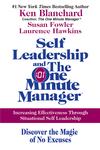|
|
BlaSelf
05-11-176 SELF LEADERSHIP AND THE ONE MINUTE MANAGER Increasing Effectiveness Through Situational Self
Leadership Ken Blanchard, Susan Fowler,
Laurence Hawkins |
|
This is another “one minute” Blanchard book. They seem to be losing punch as the series goes on. Top managers want “people who are problem solvers and are willing to take initiative, ...people who act like they own the place.” And people want honesty and opportunities to constantly learn new skills. The span of control has increased. It is not all that unusual for a manager to have 25 to 75 direct reports! “The problem is how to get people to grab hold and run with the ball that is being handed to them.” (Introduction) The book is a parable of a man paralyzed and defeated by new responsibilities who learns the tricks of self leadership. (Introduction) [The term “self leadership” always conjures up the image of a dog chasing his tail. What does this really mean? dlm] It’s easier to blame everyone else around you, rather than taking responsibility for yourself. Stop looking for excuses and start leading yourself. [Catch a glimpse of that tail back there....] Take responsibility for your own success. A boss can’t know everything you need. Take the lead to get what you need. (11-14, 26) “An assumed constraint is a belief you have, based on past experience, that limits your current and future experiences.” Challenge assumed constraints! (33, 35) You have relationship power through your contacts. Cultivate those relationships. (56) Know the nature of your strengths. (62) Three kinds of power: 1) relationship power, 2) knowledge power (abilities & skills), and 3) personal power (your credibility, authenticity, trust, etc.) “Competence means you have the knowledge and skill to accomplish the goal or do the skill in question.” (69) Your level of commitment is your motivation and confidence about the goal. (69) People go through a development continuum in learning a new skill. They begin with low competence and high commitment. They are confident but they quickly discover they have no competence. As they learn a low level of competence, their confidence (commitment) drops and they are tempted to quit. As their competence increases their confidence (commitment) varies. Eventually they get to high competence and high commitment. (70) “When your competence is low, you need direction; when your commitment is low, you need support.” (78) “The two most powerful words to collaborate for success are: “I need.” (120) State what you need in a direct, forthright manner.” (121) “There are three types of dumb questions. One, when the answer is obvious. Two, when you’re not willing to hear a certain response. And three, when you already know what you want to hear.” (122) “A leader is anyone who can give you the support and
direction you need to achieve your goal.”
(133) [I
believe Marcus Buckingham would call this person a manager. dlm] Self leaders: Challenge assumed constraints, Celebrate their points of power, and Collaborate for success. (143) * * * * |
|
* * * * *
